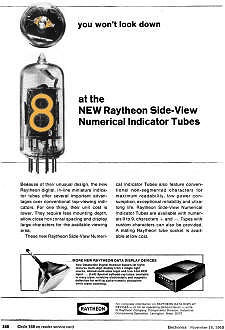|
November 15, 1965 Electronics
 [Table of Contents] [Table of Contents]
Wax nostalgic about and learn from the history of early electronics.
See articles from Electronics,
published 1930 - 1988. All copyrights hereby acknowledged.
|
Before there were side-view
neon numerical indicator vacuum tubes there were top-view neon numerical indicator
vacuum tubes. Nixie
tubes and pixie tubes were featured in "Readouts and Counter Tubes" in the October 1959 issue of Electronics
World magazine. At the time, most were top-view designs whose size was restricted
by the diameter of the tube (typically about 0.8"). Switching to a side-view format
did not enable the overall width to increase much, but the aspect ratio permitted
taller displays with characters that appear as normally seen (rather than being
squashed in height). This advertisement in a 1965 issue of Electronics
magazine for numerical indicator tubes from Raytheon were likely some of the first
side-view models available from any manufacturer.
Raytheon Numerical Indicator Tubes and Data Display Devices

you won't look down
at the New Raytheon Side-View
Numerical Indicator Tubes
Because of their unusual design, the new Raytheon digital, in-line miniature
indicator tubes offer several important advantages over conventional top-viewing
indicators. For one thing, their unit cost is lower. They require less mounting
depth, allow close horizontal spacing and display large characters for the available
viewing area.
These new Raytheon Side-View Numerical Indicator Tubes also feature conventional
non-segmented characters for maximum readability, low power consumption, exceptional
reliability and ultra-long life. Raytheon Side-View Numerical Indicator Tubes are
available with numerals 0 to 9, characters + and -. Types with custom characters
can also be provided. A mating Raytheon tube socket is available at low cost.
... More New Raytheon Data Display Devices
New Datastrobe Digital Readout System (at right) features multi-digit display
from a single light source, shared solid-state logic and true 4-bit BCD input ...
(Left) Special cathode-ray tubes, available in many sizes, combine electrostatic
and magnetic deflection for writing alpha-numeric characters while raster scanning.
Raytheon
For complete information on Raytheon Data Display Devices - or for an operating
demonstration - write
to Raytheon Company, Components Division, Industrial Components Operation, Lexington,
Mass. 02173
Posted November 30, 2023
(updated from original
post on 10/2/2018)
|





























